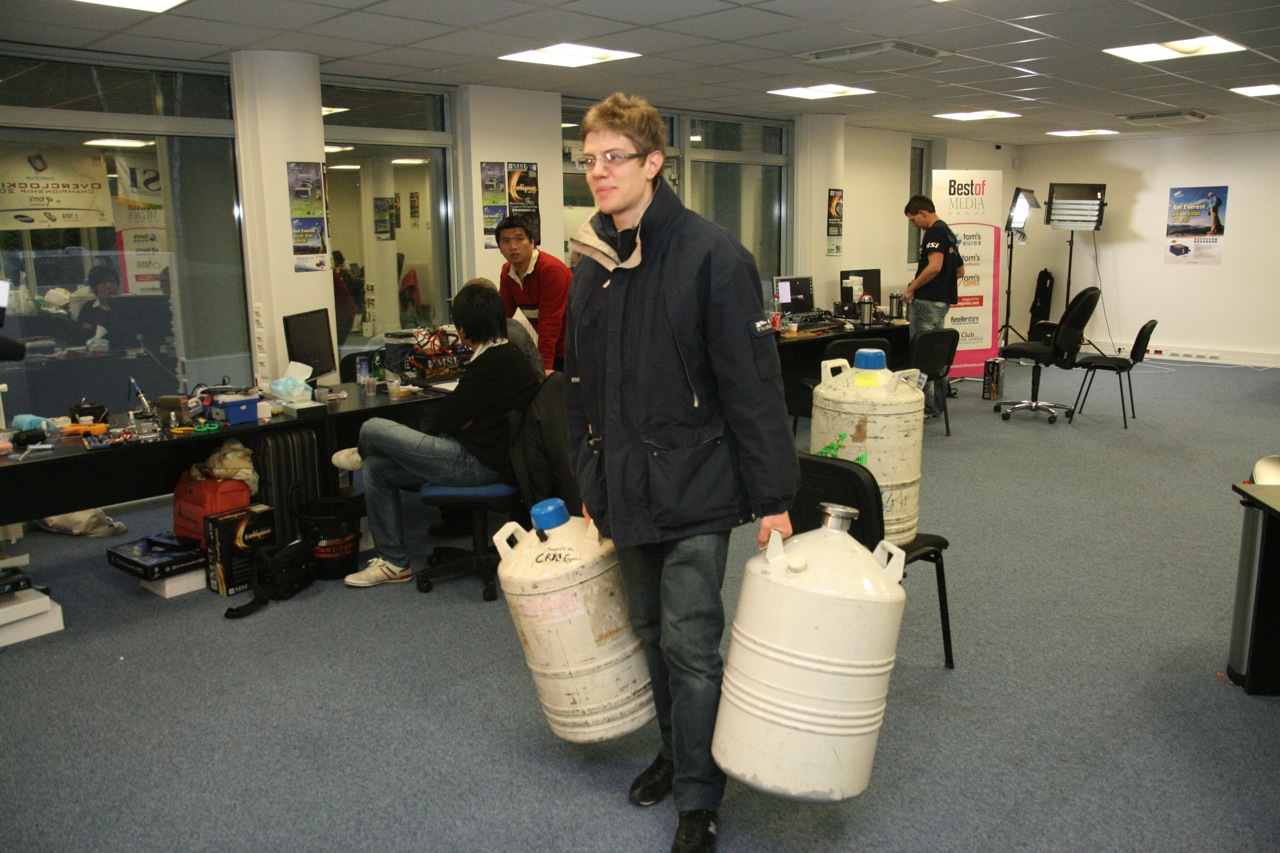Tom's Overdrive Competition: Finals Recap
Day 2: An Interesting One
The second day began with the teams in high spirits. Everyone was there—even the French! But the good vibes were not to last. From defective multi-meters (for the Germans), to results that didn’t scale at all with clock speeds and forced Windows to be installed a third time (for the French home team), to problems with Turbo Mode—all was not rosy.
A Word About Turbo
The problem with Turbo Mode—a unique feature to Core i7, but also available in a less-evolved form (IDA) on the Core 2 Duo—is that the overclocker doesn’t really control the clock frequency. Simply put, if your processor operates at 4 GHz at a voltage of 1.5 V in standard mode, certain single-threaded benchmarks could be run at 4,200 MHz, for example, and cause crashes. Remember that Turbo Mode increases the multiplier coefficient when the number of cores in use is low (1 or 2 of the 8 logical cores). Activating Turbo also activates EIST (SpeedStep), which can cause problems with stability. EIST reduces the voltage at idle, but an overclocked processor often needs a higher voltage. In practice, the easiest approach for overclockers is to disable Turbo mode, even if certain protections do remain active on the MSI X58 Eclipse.
Liquid Nitrogen And Oxygen
Our overclockers were all hungry for a win, and so the liquid nitrogen flowed like water. The teams were chilling not only the CPUS with the stuff, but the GPUs too. For once, however, the chipsets weren’t fitted with their own nitrogen canisters; the X58 is in fact nothing but a PCI Express controller, so the usual components of the northbridge are in the processor package with the Core i7.
One interesting safety issue is that using so much liquid nitrogen can cause a problem with the oxygen concentration in the air. Whereas the normal oxygen content in the atmosphere averages between 20.5 and 21%, by mid-afternoon we were measuring only 19.2%. That’s a little low, so we had to air out our offices to bring the oxygen level back up.
The Winners
Get Tom's Hardware's best news and in-depth reviews, straight to your inbox.
In the end, the Americans won the contest: Jake Crimmins, Jeremiah Allen, and Ton Khowdee posted the best scores with their Core i7 965 Extreme and MSI X58 Eclipse motherboard. The race was long and ended in a photo finish, with everybody’s scores improving right until the last minute.
| Benchmark | USA | Taiwan | Germany | France | Italy |
|---|---|---|---|---|---|
| SuperPi 1.5 1 M(s) | 8.078 | 8.157 | 8.093 | 7.987 | 7.985 |
| SuperPi 1.5 32 M (min:s) | 7 min 49.969s | 7 min 52.516s | 7 min 40.953s | 7 min 24.990s | 7 min 40.984s |
| WPrime 1.55 32 M(s) | 5.188 | 5.422 | 5.219 | 5.756 | 5.297 |
| WPrime 1.55 1024 M(s) | 160.937 | 170.375 | 165.872 | 186.982 | 165.11 |
| Row 4 - Cell 0 | 17.56 | 17.86 | 17.44 | 17.29 | 17.36 |
| AquaMark 2003 (points) | 253814 | 251703 | 319212 | 238929 | 233043 |
| 3DMark 01 (Points) | 71010 | 71591 | 72764 | 71545 | 71821 |
| 3DMark 03 (Points) | 79794 | 75002 | 76105 | 69865 | 76188 |
| 3DMark 05 (Points) | 36762 | 35893 | 36586 | 35733 | 37070 |
| 3DMark 06 (points) | 26733 | 25483 | 24194 | 22318 | 25143 |
| Score Total (Points) | 590 | 230 | 480 | 340 | 540 |
Current page: Day 2: An Interesting One
Prev Page Day 1: Delays And Water Cooling Next Page Two Interesting Overclocking Results-
neiroatopelcc Bit late to read this, but oh well.Reply
Can someone tell me the point of adding salt to the water in order to avoid freezing? Far as I know, salt doesn't work once the temperatures exceed minus 10C degrees? at least it doesn't on the danish roads.
Adding alcohol would've probably worked better.
